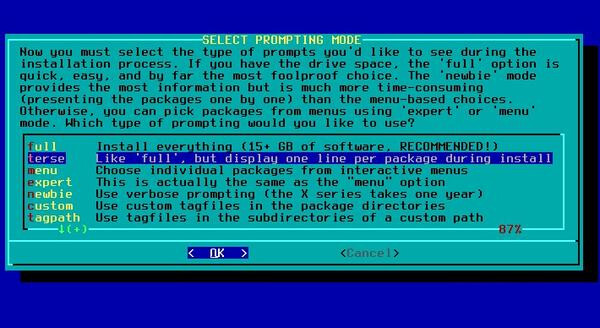Blog post alert
Let me start off by saying: If you just want to have a working system to do your thing with minimal effort, Slackware isn't for you (anymore).
Running Slackware today is like being gifted a Ford Model T by a weird, bearded museum curator, and then finding out that after some minor modifications and learning how to drive it, you can keep up with any modern car on the road. Only it has no ABS, AC, power steering, starter motor, crumple zones, airbags or seatbelts.
Most people who still run it (by any realistic estimate, fewer than 10000 people in the world now) have been running it since the 90's and follow the advice not to change a running system to the letter. So why should anyone who hasn't studied CompSci in Berkeley in the 90's try it today?
First of all, the most widely known criticism (it has no dependency resolution) is a bit of a misunderstanding. Slackware is different. The recommended installation method is a full installation, which means you install everything in the repository up front. That way, all dependencies are already resolved. And you have a system you can use equally well on a desktop or server. It uses 20GB but disk space is essentially free now.
What if you need something that isn't in the repo? Well, do whatever the fuck you want. Use Slackbuilds, which aren't officially supported but endorsed by Slackware's dev. Use Sbopkg, a helper script with dependency resolution very much like Arch's AUR helpers. Use the repos of sister distros like SalixOS that include dependency resolution. Install RPM packages. Install Flatpaks. Unpack tarballs wherever you want them. Go the old school way of compiling from source and administering your own system yourself. Slackware doesn't get in the way of whatever you want to do, cause there's nothing there to get in the way.
It's the most KISS distro that exists. It's the most stable one, too. Any distro-specific knowledge you acquire will stay valid for decades cause the distro hardly ever changes. It's also the closest to "Vanilla Linux" you can get. Cause there really isn't anything there except for patched, stable upstream software and a couple of bash scripts.
Just be mindful of the fact that Slackware is different (because the Linux ecosystem as a whole has moved on from its roots).
One example:
Up-to-date Slackware documentation isn't on Google, it's in text files written by the guy who maintained the distro for 31 years, which come preinstalled with your system. Or on linuxquestions.org, where the same guy posts, asks for input from users, and answers questions regularly.
It's still a competent system, if you have the time and inclination to make it work. And it's a blast from the past, where computing was about collaborating with like-minded freaks on a personal level. And I love that.

I think it's a way to get to know and learn Linux from the ground up while you install it, configure it to your taste, and fix all the little issues that pop up, a bit like Linux From Scratch. But when you're done, you have a working system you know well and that won't ever surprise you.
Working system until you need to upgrade something. I feel like the BSD systems are really what you want if a system like Slackware is what interests you. They have a tightly integrated core system with the kernel, and a ports tree to compile software from source with automatic dependency compilation. A lot of ports can be found as pre-compiled binaries.
All this with simple old school unix tools such as tar, cvs and make. All config is text files, everything meticulously documented in man pages. Very easy to upgrade.
I'd actually love BSD and have tried it out in the past. But my only computing device is a convertible laptop, and BSD didn't support energy management, battery monitoring, decent WiFi speeds, the touch screen or the tablet pen on it. And the fingerprint reader threw errors that kept filling up the screen, even on top of the installer TUI, until I disabled it in BIOS.
Which bsd? I'd expect there to be packages for all that except modern wifi
FreeBSD .
I would say OpenBSD is closer to the Slackware idea. You install the system and it works how it was designed. It might not be what you want, but if you are a security-minded C programmer, OpenBSD gives you the full experience out of the box.
It is not for everybody. But if you are in the crowd who consider Slackware, things like fingerprint reader or wifi are not the first things that are important for you.
Get a ThinkPad X230 and go with OpenBSD to get some of that old school unix feeling.
I'd beg to differ.
T420 is more old-school.
Why are you attempting to upgrade slack? You install, configure to purpose and leave it be. When it's purpose changes you re-install and re-configure! Nothing could be simpler!